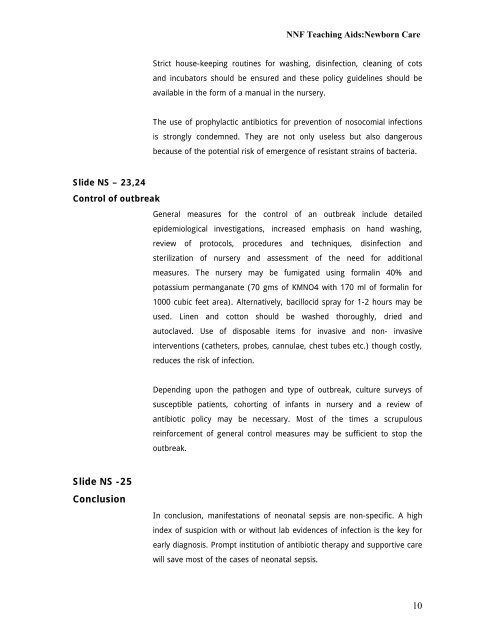Neonatal sepsis - New Born Baby
Neonatal sepsis - New Born Baby Neonatal sepsis - New Born Baby
Slide NS – 23,24 Control of outbreak Slide NS -25 Conclusion NNF Teaching Aids:Newborn Care Strict house-keeping routines for washing, disinfection, cleaning of cots and incubators should be ensured and these policy guidelines should be available in the form of a manual in the nursery. The use of prophylactic antibiotics for prevention of nosocomial infections is strongly condemned. They are not only useless but also dangerous because of the potential risk of emergence of resistant strains of bacteria. General measures for the control of an outbreak include detailed epidemiological investigations, increased emphasis on hand washing, review of protocols, procedures and techniques, disinfection and sterilization of nursery and assessment of the need for additional measures. The nursery may be fumigated using formalin 40% and potassium permanganate (70 gms of KMNO4 with 170 ml of formalin for 1000 cubic feet area). Alternatively, bacillocid spray for 1-2 hours may be used. Linen and cotton should be washed thoroughly, dried and autoclaved. Use of disposable items for invasive and non- invasive interventions (catheters, probes, cannulae, chest tubes etc.) though costly, reduces the risk of infection. Depending upon the pathogen and type of outbreak, culture surveys of susceptible patients, cohorting of infants in nursery and a review of antibiotic policy may be necessary. Most of the times a scrupulous reinforcement of general control measures may be sufficient to stop the outbreak. In conclusion, manifestations of neonatal sepsis are non-specific. A high index of suspicion with or without lab evidences of infection is the key for early diagnosis. Prompt institution of antibiotic therapy and supportive care will save most of the cases of neonatal sepsis. 10
- Page 1 and 2: Slide NS -1 Definition Slide NS -2
- Page 3 and 4: NNF Teaching Aids:Newborn Care TABL
- Page 5 and 6: Slide NS -13,14 Supportive care or
- Page 7 and 8: NNF Teaching Aids:Newborn Care TABL
- Page 9: Slide NS-19,20 Hand washing Slide N
Slide NS – 23,24<br />
Control of outbreak<br />
Slide NS -25<br />
Conclusion<br />
NNF Teaching Aids:<strong>New</strong>born Care<br />
Strict house-keeping routines for washing, disinfection, cleaning of cots<br />
and incubators should be ensured and these policy guidelines should be<br />
available in the form of a manual in the nursery.<br />
The use of prophylactic antibiotics for prevention of nosocomial infections<br />
is strongly condemned. They are not only useless but also dangerous<br />
because of the potential risk of emergence of resistant strains of bacteria.<br />
General measures for the control of an outbreak include detailed<br />
epidemiological investigations, increased emphasis on hand washing,<br />
review of protocols, procedures and techniques, disinfection and<br />
sterilization of nursery and assessment of the need for additional<br />
measures. The nursery may be fumigated using formalin 40% and<br />
potassium permanganate (70 gms of KMNO4 with 170 ml of formalin for<br />
1000 cubic feet area). Alternatively, bacillocid spray for 1-2 hours may be<br />
used. Linen and cotton should be washed thoroughly, dried and<br />
autoclaved. Use of disposable items for invasive and non- invasive<br />
interventions (catheters, probes, cannulae, chest tubes etc.) though costly,<br />
reduces the risk of infection.<br />
Depending upon the pathogen and type of outbreak, culture surveys of<br />
susceptible patients, cohorting of infants in nursery and a review of<br />
antibiotic policy may be necessary. Most of the times a scrupulous<br />
reinforcement of general control measures may be sufficient to stop the<br />
outbreak.<br />
In conclusion, manifestations of neonatal <strong>sepsis</strong> are non-specific. A high<br />
index of suspicion with or without lab evidences of infection is the key for<br />
early diagnosis. Prompt institution of antibiotic therapy and supportive care<br />
will save most of the cases of neonatal <strong>sepsis</strong>.<br />
10



